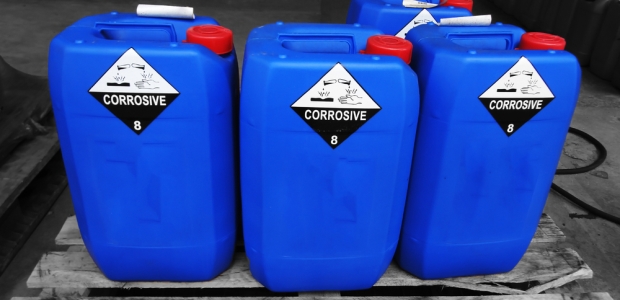
Keep Hazmats in Their Containers
Stocking spill response supplies such as squeegees, absorbents and wipes in areas where hazardous materials are used, handled, and stored allows employees to immediately respond to incidental spills.
- By Karen D. Hamel
- Nov 09, 2016
Keeping employees safe from hazardous materials that are used, handled, and stored throughout the facility involves more than reviewing safety data sheets and providing basic hazard communication training. Incorporating container management best practices into HazCom training will help keep employees safer no matter where a hazardous material is encountered.
When they are in their containers, hazardous materials typically present a low level of risk. There are some hazmats that have special handling procedures, such as keeping the container at a certain temperature or ensuring that it does not build up pressure but, in general, most hazardous materials that are in closed containers don’t presenting an eminent safety hazard to employees.
Reviewing Chemical Inventories
Knowing what hazardous materials are on site should be the easy part: Just check the chemical inventory list. Usually, the bigger issue is determining all of the places that each of the materials on the list may be stored and used. A single chemical often has multiple locations: containers in the warehouse or outdoor bulk storage tanks, smaller cans, buckets or bottles in the production area, and even more in laboratories and other areas.
While it is important that all employees who may handle or work with hazardous chemicals understand the risks of the products they work with, an employee in the warehouse moving a 55-gallon drum should not receive the same handling training as an employee in the production area who is pumping liquid from a drum into a smaller container for use in a process.
Transferring Hazmats
Whether they arrive in one-ounce bottles or in 30,000-gallon bulk tanker loads, it's common for hazardous materials to be moved from one container to another. Each time this happens, it increases the likelihood for employees to be exposed, especially if the materials can spill, leak, or drip.
Establishing a preventative maintenance program and performing regular inspections on bulk tanks, pipelines and transfer hoses minimizes the chance of failure which could expose employees. Coupled with transfer procedures that ensure connections are secure before product transfers begin, bulk fluid transfers can remain safe.
For smaller-volume transfers, selecting the right transfer pump or dispensing faucet will help minimize employee exposures to hazardous materials. For example, if only a few ounces of fluid are needed, select a faucet or pump with a low flow rate. And for those times when leaks or drips do occur, having good housekeeping procedures and a sufficient quantity of wipes, absorbents, or other tools readily available to clean them up quickly will help increase safety and minimize the chance of slip-and-fall incidents.
Covering Collection Containers
Some facilities channel spent chemicals to floor drains that lead to an on-site treatment facility. Others collect spent hazardous materials in drums or portable aboveground storage tanks. Like fluids being dispensed, collecting fluids involves transferring them from one container into another, increasing the likelihood of exposure.
EPA requires any container holding hazardous wastes to be kept closed, except when materials are being added to or removed from it. Keeping containers closed eliminates harmful fugitive emissions and decreases the likelihood of a spill if the collection container is tipped or dropped.
Having procedures to keep containers closed can also aid in waste segregation. When lids and funnel covers are kept clean and properly labeled to identify the container contents, it is less likely for someone to inadvertently put the wrong waste into a container. This can be especially important in facilities that use, store, and handle incompatible materials.
Shipping Preparations
The DOT defines any employee who handles or prepares containers of hazardous materials for shipment as a "hazmat employee" and requires them to be properly trained. A hazmat employee who chooses shipping containers needs to have the knowledge to choose a container that is suitable for materials being shipped.
This includes knowing the proper shipping name for the hazardous material, its packing group, and any shipping restrictions. Choosing an unsuitable container can cause it to fail during shipping, releasing the chemical into the environment and potentially harming people in the area.
Secondary Containment
Even with good housekeeping practices and solid standard operating procedures in place, containers may still leak, pipes and hoses may still fail, and containers with funnels can still overflow. Predicting where these things may happen is nearly impossible.
Providing secondary containment won't stop any of these events, but it will keep the released materials in a confined area. Confining spills with secondary containment pallets, dikes, or dams limits the exposure area. The smaller the area, the fewer the emissions and the faster it is to clean up the area.
Responding Quickly
Not every hazmat spill happens in an area outfitted with secondary containment devices. Stocking spill response supplies such as squeegees, absorbents, and wipes in areas where hazardous materials are used, handled, and stored allows employees to immediately respond to incidental spills.
Establishing guidelines for responding to hazmat spills is an essential part of training. If a spill poses an immediate threat to employee safety and health, anyone responding will need specialized training under OSHA's Hazardous Waste Operations and Emergency Response Standard. If spills do not pose an immediate emergency—even though the chemicals may still pose some type of hazard—spill response training can be incorporated into routine procedures and taught as part of hazard communication training.
Communicating the safety hazards of chemicals used in the workplace is the first step in helping employees avoid risk and work safely with those chemicals. Expanding this knowledge to include good housekeeping and proper container management practices that keep hazmats in their containers provides an added layer of safety that minimizes the potential for chemical releases and other situations that expose employees to hazardous materials.
This article originally appeared in the December 2016 issue of Occupational Health & Safety.